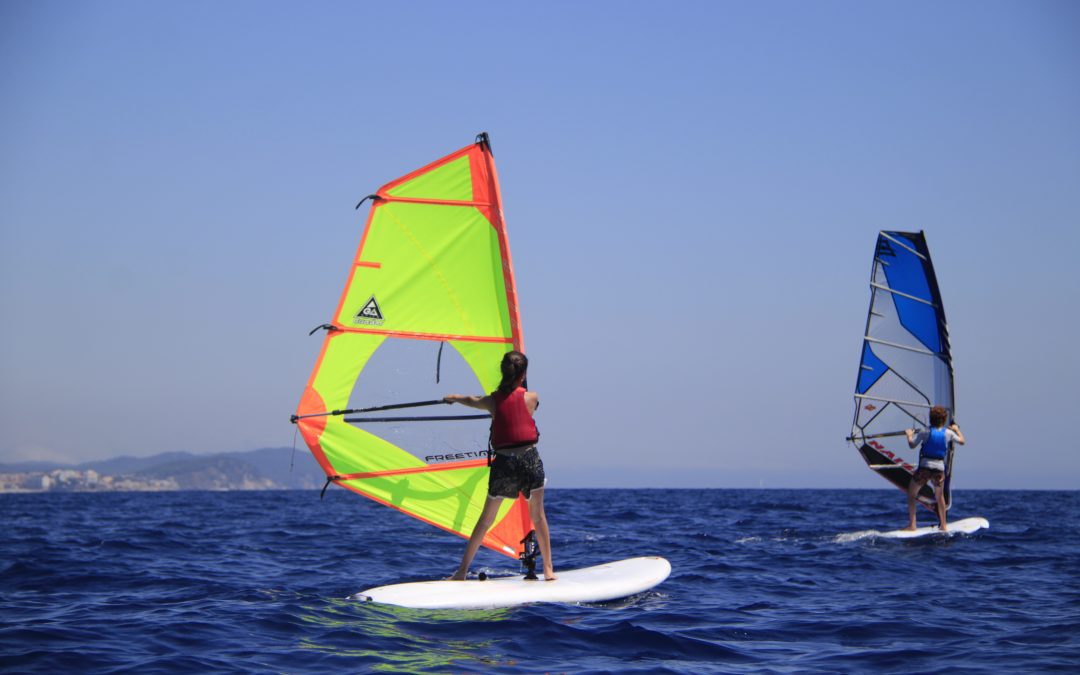Wind: a living force of the Mediterranean
Wind is one of nature’s most vivid and changeable forces. We feel it on our skin, in our sails, and in the colour of the Mediterranean Sea along the Costa Brava. But understanding it goes far beyond checking an app or a compass—especially for anyone practising sailing or watersports in Platja d’Aro.
In marine meteorology, the cardinal points are a reference: we talk about north, south, east or west winds depending on where they blow from. In practice, however, wind on the Costa Brava is a continuum: it oscillates, shifts and mixes with thermal breezes or local turbulence.
Every stretch of the Mediterranean coastline develops its own wind character depending on relief and orientation. On the Costa Brava, this identity is especially marked and essential for sailing.
A coastline with identity: Vall d’Aro and its orography
Platja d’Aro, in the heart of the central Costa Brava, is part of the Vall d’Aro, a coastal valley open to the sea and surrounded by mountains that define its Mediterranean microclimate.
To the north lies the Gavarres Massif, whose heights dominate the Baix Empordà landscape and act as a barrier to certain continental winds.
To the south rises the Cadiretes (Ardenya-Cadiretes) Massif, with the Puig de les Cadiretes as its highest point at 519 metres.
Just south of the Platja Gran de Platja d’Aro stretches the coastal headland of S’Agaró, a rocky, built-up strip that, though not high, partially shelters the bay from southeasterly winds and alters the wave dynamics.
This orographic layout—an open plain between two mountain massifs—creates a very particular local wind dynamic on the Costa Brava.
Platja Gran de Platja d’Aro, oriented from N-NE to S-SW, can receive northerly winds (such as tramuntana or gregal), southerly or southwesterly winds (such as garbí or xaloc) and levante/easterlies, depending on season and weather.
Weather models: useful, not infallible
Apps like Windy, Windguru or Meteocat are great allies when planning a sailing day or lessons on the Costa Brava.
However, their models compute wind about 10 metres above ground on regional scales, and they don’t always capture the local effects of coastal relief.
In the Vall d’Aro, factors include:
- Wind channelling along the valley.
- Orographic shadows created by Cadiretes and S’Agaró.
- The sea breeze between sea and land.
- Height-dependent variations.
This is why actual wind in Platja d’Aro can differ notably from maps.
Direct observation of the Mediterranean and navigator experience remain the best tools on the Costa Brava.
The science and practice of wind
Mediterranean wind originates from differences in atmospheric pressure: air moves from high to low pressure areas seeking balance.
Other factors include sea temperature, solar radiation, terrain roughness and the Coriolis effect, which deflects flows due to Earth’s rotation.
During the day, the land heats up faster than the sea, generating sea breezes; at night, the process reverses.
This cycle explains why in summer wind on the Costa Brava is lighter in the morning, rises by mid‑afternoon and eases at dusk—a natural rhythm well known to local sailors.
The most frequent winds on the Costa Brava
Each day at sea is different, but Mediterranean winds have distinct names and personalities:
🌬️ Tramuntana
A dry, gusty northerly. Channelled between the Pyrenees and the Gulf of Lion. Typical of winter; it leaves clear skies and white‑capped seas.
🌤️ Garbí
A mild, humid southwesterly, common on summer afternoons. Ideal to sail, windsurf or learn dinghy sailing on the Costa Brava.
🌊 Xaloc
A southeasterly associated with Mediterranean storms. It can raise swell and bring rain.
🌫️ Gregal
A fresh, steady northeasterly, usual in spring and autumn.
🌅 Levante (Easterly)
A humid, persistent easterly that can bring cloud and waves. One of the best‑known winds on the Mediterranean coast, often heralding a change in the weather.
🍃 Local breezes
Daily thermal phenomena, gentle, veering from morning to afternoon. These Costa Brava sea breezes make learning to read the wind a constant adventure.
Deciding to head out: science, common sense and respect
Knowing the wind on the Costa Brava isn’t just technical: it’s about safety, respect and judgement for those practising sailing, windsurf or wingfoil.
Before casting off, check the forecast, watch the sea, and know your boat’s limits and your experience level.
There’s no “good” or “bad” wind—it depends on the day you want to have.
At Set Sail Costa Brava, we live with the wind every day. We measure it, feel it and study it.
Because sailing isn’t fighting the wind:
it’s understanding the Mediterranean wind, interpreting it and learning from it.
🌬️ Discover the wind with us
Come and feel the Costa Brava wind.
On our guided kayak tours, dinghy sailing courses, windsurf and wingfoil sessions, you’ll learn to read the sky, feel the gusts and discover that behind every breath of air there’s a story the sea wants to tell.
👉 Book your next nautical experience in Platja d’Aro with Set Sail Costa Brava and enjoy the sea—with or without wind.

